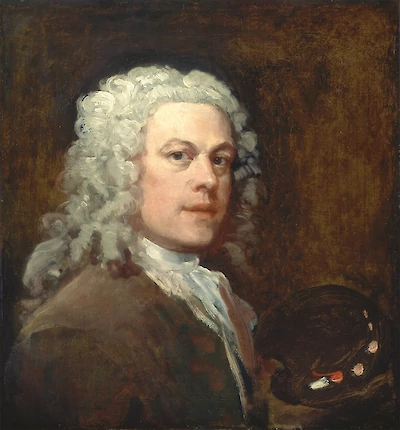

William Hogarth
A printmaker analyzes taste — and beauty comes out on top
1697 – 1764Such dispositions of the body and limbs as appear most graceful when seen at rest, depend upon gentle winding contrasts, mostly governed by the precise serpentine-line, which, in attitudes of authority, are more extended and spreading than ordinary, but reduced somewhat below the medium of grace, in those of negligence and ease: and as much exaggerated in insolent and proud carriage, or in distortions of pain, see figure 2, plate 7 as lessened and contracted into plain and parallel lines, to express meanness, awkwardness and submission.
The general idea of an action, as well as of an attitude, may be given with a pencil in very few lines. It is easy to conceive that the attitude of a person upon the cross, may be fully signified by the two straight lines of the cross; so the extended manner of St. Andrew’s crucifixion is wholly understood by the X like cross.
Thus, as two or three lines at first are sufficient to show the intention of an attitude, I will take this opportunity of presenting my reader, who may have been at the trouble of following me thus far, with the sketch of a country dance, in the manner I began to set out the design; in order to show how few lines are necessary to impress the first thoughts, as to different attitudes ; see figure 1, plate 30, which describe, in some measure, the several figures and actions, mostly of the ridiculous kind, that are represented in the chief part of the frontispiece.
The most amiable person may deform his general appearance by throwing his body and limbs into plain lines, but such lines appear still in a more disagreeable light in people of a particular make; I have therefore chosen such figures as I thought would agree best with my first score of lines, figure 1 .
The two parts of curves at the right, served for the figures of the old woman and her partner at the farther end of the room. The curve and two straight lines at right angles, gave the hint for the fat man’s sprawling posture. I next resolved to keep a figure within the bounds of a circle, which produced the upper part of the fat woman, between the fat man and the awkward one in the bag wig, for whom I had made a sort of an X. The prim lady, his partner, in the riding habit, by pecking back her elbows, as they call it, from the waist upwards, made a tolerable D, with a straight line imder it, to signify the scanty stiffness of her petticoat; and a Z stood for the angular position the body makes with the legs and thighs of the affected fellow in the tye-wig; the upper part of his plump partner was confined to an O, and this changed into P, served as a hint for the straight lines behind. The uniform diamond of a card, was filled up by the flying dress, etc. of the little capering figure in the Spencer- wig; while a double L marked the parallel position of his poking partner’s hands and arms; and lastly, the two waving lines were drawn for the more genteel turns of the two figures at the hither end.
The best representation in a picture, of even the most elegant dancing, as every figure is rather a suspended action in it, than an attitude, must be always somewhat unnatural and ridiculous; for were it possible in a real dance to fix every person at one instant of time, as in a picture, not one in twenty would appear to be graceful, though each were ever so much so in their movements; nor could the figure of the dance itself be at all understood.
The dancing room is also ornamented purposely with such statues and pictures as may serve to a farther illustration. Henry the Eighth, in the first niche from the musicians, makes a perfect X with his legs and arms; and the position of Charles the First, in the first picture, is composed of less varied lines than the statue of Edward the Sixth, in the second niche, and the medal over his head is in the like kind of lines; but that over Queen Elizabeth, in the third niche, as well as her figure, is in the contrary; so are also the two other wooden figures at the end. Likewise the comical posture of astonishment, expressed by following the direction of one plain curve, as the dotted line in a French print of Sancho, where Don Quixote demolishes the puppet show, figure 1, plate 31 is a good contrast to the effect of the serpentine-lines in the fine turn of the Samaritan woman, figure 2, plate 31, taken from one of the best pictures Annibal Carrache ever painted.